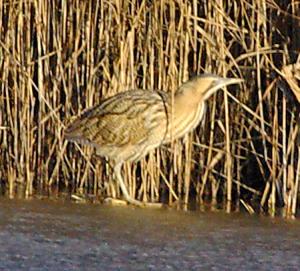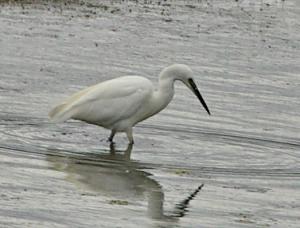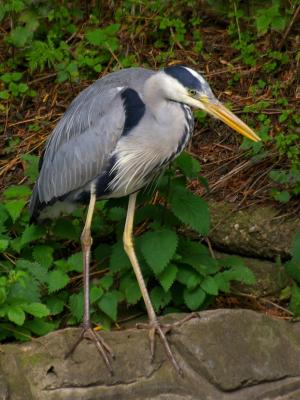


Austen Dobbs in "The Birds of Nottinghamshire {1975}" regarded the status of the Bittern in Nottinghamshire as a rare winter visitor
, occurring most years. Sterland and Whitaker thought of it as a declining winter visitor in the second half of the eighteenth century. Sterland also mentioned the lack of suitable habitat for it in Nottinghamshire.
The Bittern is still considered a rare winter visitor to Nottinghamshire, arriving in November and usually leaving in February, although some individuals have remained into spring and 'boom'. Because it spends its life in reedbeds it can be very difficult to see. The best times are during hard weather when the water in the reedbeds is frozen and the birds have to venture into the open to feed. Also if the preceding autumn was dry and the water levels are low, then the birds are again forced out to feed.
The best place to see them in Nottinghamshire is Attenborough Nature Reserve where up to three Bitterns have been present in recent winters. The RSPB has built an entire habitat to attract Bitterns at Langford Lowfields. It is intended to have a large enough reedbed to support two 'booming' Bitterns. In a paper published in IBIS (Vol 147) in 2005 by Gilbert, Tyler and Smith, radio tagged Bitterns were studied and it was found that their preference for feeding was in water of around 20cm deep and adjacent to pools, rather than channels or ditches. The home sizes of 'booming' birds territory was around 15 hectares and twice that in the winter.

The Little Egret was not mentioned by either Sterland or Whitaker in the nineteenth century and the first record for Nottinghamshire appears to be in 1970.
Since the mid 1990s Little Egrets have increased their numbers, especially in late summer and early autumn when the birds appear to wander around England. Most birds are present in the Besthorpe, Collingham and Langford areas. Little Egrets are also regular further south in the Trent Valley at Attenborough N. R., Netherfield and Hoveringham.

Sterland in the "Descriptive list of the birds of Nottinghamshire {1879}" considered it a common enough bird and mentioned heronies at Thoresby, Clumber and Colwick.
In "The Birds of Nottinghamshire {1975}" Austen Dobbs lists the rise and fall of several heronies in the first 60 years of the twentieth century. Several declined because of human persecution (eg East Stoke), others because of flood prevention work (Colwick Park for instance).
Grey Herons have been the object of the second longest running bird survey in Britain. For Nottinghamshire some counts of nests are; in 1928, 88/90; in 1970, 46. After the hard winter of 1962/3 there was only 16 pairs, by 1999 with less persecution and milder winters, there were 236 nesting pairs of birds. Two large heronies have disappeared in the past 10/15 years, quite possibly because of the spread of Buzzards to the area. Welbeck held c50 nests in the 1990s and Branshill (Barton-in-Fabis) held around the same number.
The Grey Heron is a fairly common bird in Nottinghamshire especially anywhere there is water, although they can be seen in fields especially after harvesting.
Any criticisms, corrections or comments to the author Derek Huskisson

This work is licensed under a Creative Commons Attribution-Noncommercial-Share Alike 2.0 UK: England & Wales License.